Fertile Crescent
The Fertile Crescent is a crescent-shaped region in the Middle East, spanning modern-day Iraq, Syria, Lebanon, Palestine, Israel, Jordan, Egypt, together with the southeastern region of Turkey and the western fringes of Iran.[1][2] Some authors also include Cyprus.
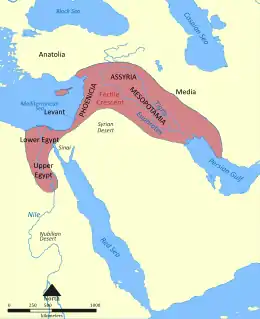
The region is one of the cradles of civilization because it is where settled farming first emerged as people started the process of clearance and modification of natural vegetation in order to grow newly domesticated plants as crops. Early human civilizations such as Sumer in Mesopotamia flourished as a result.[3] Technological advances in the region include the development of agriculture and the use of irrigation, of writing, the wheel, and glass, most emerging first in Mesopotamia.
Terminology
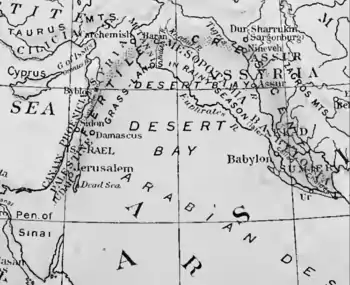
The term "Fertile Crescent" was popularized by archaeologist James Henry Breasted in Outlines of European History (1914) and Ancient Times, A History of the Early World (1916).[4][5][6][7][8][9] Breasted wrote:[4]
This fertile crescent is approximately a semicircle, with the open side toward the south, having the west end at the southeast corner of the Mediterranean, the center directly north of Arabia, and the east end at the north end of the Persian Gulf (see map, p. 100). It lies like an army facing south, with one wing stretching along the eastern shore of the Mediterranean and the other reaching out to the Persian Gulf, while the center has its back against the northern mountains. The end of the western wing is Palestine; Assyria makes up a large part of the center; while the end of the eastern wing is Babylonia.
This great semicircle, for lack of a name, may be called the Fertile Crescent.1 It may also be likened to the shores of a desert-bay, upon which the mountains behind look down—a bay not of water but of sandy waste, some eight hundred kilometres across, forming a northern extension of the Arabian desert and sweeping as far north as the latitude of the northeast corner of the Mediterranean. This desert-bay is a limestone plateau of some height—too high indeed to be watered by the Tigris and Euphrates, which have cut cañons obliquely across it. Nevertheless, after the meager winter rains, wide tracts of the northern desert-bay are clothed with scanty grass, and spring thus turns the region for a short time into grasslands. The history of Western Asia may be described as an age-long struggle between the mountain peoples of the north and the desert wanderers of these grasslands—a struggle which is still going on—for the possession of the Fertile Crescent, the shores of the desert-bay.
1 There is no name, either geographical or political, which includes all of this great semicircle (see map, p. 100). Hence we are obliged to coin a term and call it the Fertile Crescent.
In current usage, the Fertile Crescent includes Israel, Palestine, Iraq, Syria, Lebanon, Egypt, and Jordan, as well as the surrounding portions of Turkey and Iran. In addition to the Tigris and Euphrates, riverwater sources include the Jordan River. The inner boundary is delimited by the dry climate of the Syrian Desert to the south. Around the outer boundary are the Anatolian and Armenian highlands to the north, the Sahara Desert to the west, Sudan to the south, and the Iranian Plateau to the east.
Biodiversity and climate
As crucial as rivers and marshlands were to the rise of civilization in the Fertile Crescent, they were not the only factor. The area is geographically important as the "bridge" between North Africa and Eurasia, which has allowed it to retain a greater amount of biodiversity than either Europe or North Africa, where climate changes during the Ice Age led to repeated extinction events when ecosystems became squeezed against the waters of the Mediterranean Sea. The Saharan pump theory posits that this Middle Eastern land bridge was extremely important to the modern distribution of Old World flora and fauna, including the spread of humanity.
The area has borne the brunt of the tectonic divergence between the African and Arabian plates and the converging Arabian and Eurasian plates, which has made the region a very diverse zone of high snow-covered mountains.
The Fertile Crescent had many diverse climates, and major climatic changes encouraged the evolution of many "r" type annual plants, which produce more edible seeds than "K" type perennial plants. The region's dramatic variety in elevation gave rise to many species of edible plants for early experiments in cultivation. Most importantly, the Fertile Crescent was home to the eight Neolithic founder crops important in early agriculture (i.e., wild progenitors to emmer wheat, einkorn, barley, flax, chick pea, pea, lentil, bitter vetch), and four of the five most important species of domesticated animals—cows, goats, sheep, and pigs; the fifth species, the horse, lived nearby.[10] The Fertile Crescent flora comprises a high percentage of plants that can self-pollinate, but may also be cross-pollinated.[10] These plants, called "selfers", were one of the geographical advantages of the area because they did not depend on other plants for reproduction.[10]
History
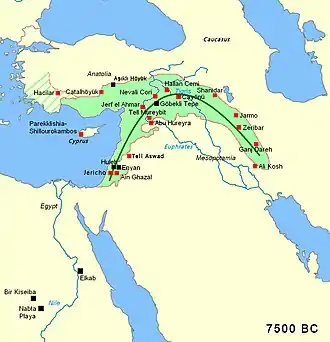
As well as possessing many sites with the skeletal and cultural remains of both pre-modern and early modern humans (e.g., at Tabun and Es Skhul caves in Israel), later Pleistocene hunter-gatherers, and Epipalaeolithic semi-sedentary hunter-gatherers (the Natufians); the Fertile Crescent is most famous for its sites related to the origins of agriculture. The western zone around the Jordan and upper Euphrates rivers gave rise to the first known Neolithic farming settlements (referred to as Pre-Pottery Neolithic A (PPNA)), which date to around 9,000 BCE and includes very ancient sites such as Göbekli Tepe, Chogha Golan, and Jericho (Tell es-Sultan).
This region, alongside Mesopotamia (Greek for "between rivers", between the rivers Tigris and Euphrates, lies in the east of the Fertile Crescent), also saw the emergence of early complex societies during the succeeding Bronze Age. There is also early evidence from the region for writing and the formation of hierarchical state level societies. This has earned the region the nickname "The cradle of civilization".
It is in this region where the first libraries appeared, about 4,500 years ago. The oldest known libraries are found in Nippur (in Sumer) and Ebla (in Syria), both from c. 2500 BCE.[11]
Both the Tigris and Euphrates start in the Taurus Mountains of what is modern-day Turkey. Farmers in southern Mesopotamia had to protect their fields from flooding each year; northern Mesopotamia had just enough rain to make some farming possible. To protect against flooding, they made levees.[12]
Since the Bronze Age, the region's natural fertility has been greatly extended by irrigation works, upon which much of its agricultural production continues to depend. The last two millennia have seen repeated cycles of decline and recovery as past works have fallen into disrepair through the replacement of states, to be replaced under their successors. Another ongoing problem has been salination—gradual concentration of salt and other minerals in soils with a long history of irrigation.
Early domestications
Prehistoric seedless figs were discovered at Gilgal I in the Jordan Valley, suggesting that fig trees were being planted some 11,400 years ago.[13] Cereals were already grown in Syria as long as 9,000 years ago.[14] Small cats (Felis silvestris) also were domesticated in this region.[15] In addition to cereals, legumes including peas, lentils and chickpea were domesticated in this region.
Domesticated animals include the cattle, sheep, goat, domestic pig, cat, and domestic goose.
Cosmopolitan diffusion
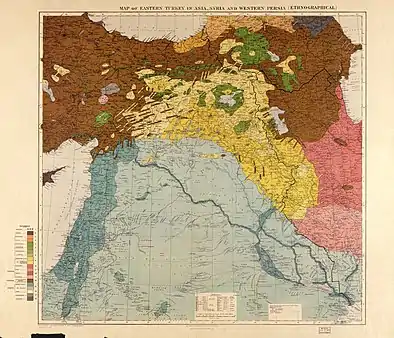
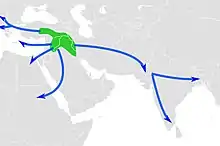
| The ancient Near East |
|---|
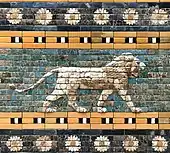 |
| Regions and states |
|
The Levant |
| Archaeological periods |
| Languages |
| Literature |
| Mythology |
| Other topics |
|
Modern analyses[16][17] comparing 24 craniofacial measurements reveal a relatively diverse population within the pre-Neolithic, Neolithic and Bronze Age Fertile Crescent,[16] supporting the view that several populations occupied this region during these time periods.[16][18][19][20][21][22][23] Similar arguments do not hold true, however, for the Basques and Canary Islanders of the same time period, as the studies demonstrate those ancient peoples to be "clearly associated with modern Europeans". Additionally, no evidence from the studies demonstrates Cro-Magnon influence, contrary to former suggestions.[16]
The studies further suggest a diffusion of this diverse population away from the Fertile Crescent, with the early migrants moving away from the Near East—westward into Europe and North Africa, northward to Crimea, and eastward to Mongolia.[16] They took their agricultural practices with them and interbred with the hunter-gatherers whom they subsequently came in contact with while perpetuating their farming practices. This supports prior genetic[24][25][26][27][28] and archaeological[16][29][30][31][32][33] studies which have all arrived at the same conclusion.
Consequently, contemporary in-situ peoples absorbed the agricultural way of life of those early migrants who ventured out of the Fertile Crescent. This is contrary to the suggestion that the spread of agriculture disseminated out of the Fertile Crescent by way of sharing of knowledge. Instead the view now supported by a preponderance of the evidence is that it occurred by actual migration out of the region, coupled with subsequent interbreeding with indigenous local populations whom the migrants came in contact with.[16]
The studies show also that not all present day Europeans share strong genetic affinities to the Neolithic and Bronze Age inhabitants of the Fertile Crescent;[16] instead the closest ties to the Fertile Crescent rest with Southern Europeans.[16] The same study further demonstrates all present-day Europeans to be closely related.[16]
Languages
Linguistically, the Fertile Crescent was a region of great diversity. Historically, Semitic languages generally prevailed in the modern regions of Iraq, Syria, Jordan, Lebanon, Israel, Palestine, Sinai and the fringes of southeast Turkey and northwest Iran, as well as the Sumerian (a language isolate) in Iraq, whilst in the mountainous areas to the east and north a number of generally unrelated language isolates were found, including; Elamite, Gutian and Kassite in Iran, and Hattic, Kaskian and Hurro-Urartian in Turkey. The precise affiliation of these, and their date of arrival, remain topics of scholarly discussion. However, given lack of textual evidence for the earliest era of prehistory, this debate is unlikely to be resolved in the near future.
The evidence that does exist suggests that, by the third millennium BCE and into the second, several language groups already existed in the region. These included:[34][35][36][37][38][39]
- Northeast Caucasian languages:[40] Possibly including Hurro-Urartian languages, a small branch possibly also related to the Kassite language spoken in the Northern part of the region
- Proto-Euphratean language: a non-Semitic language considered to be the substratum language of the people that introduced farming into Southern Iraq in the Early Ubaid period (5300–4700 BCE)
- Sumerian: a non-Semitic language isolate that displays a Sprachbund-type relationship with neighbouring Semitic Akkadian
- Semitic languages: Akkadian (aka Assyrian and Babylonian), Eblaite, Amorite, Aramaic, Ugaritic, Canaanite languages (including Hebrew, Moabite, Edomite, Phoenician/Carthaginian)
- Hattic: a language isolate, spoken originally in central Anatolia
- Indo-European languages: generally believed to be later intrusive languages arriving after 2000 BCE, such as Hittite, Luwian and the Indo-Aryan material attested in the Mitanni civilization
- Egyptian: a stand-alone branch of the Afroasiatic languages confined to Egypt
Links between Hurro-Urartian and Hattic and the indigenous languages of the Caucasus have frequently been suggested, but are not generally accepted.
Notes and references
- Haviland, William A.; Prins, Harald E. L.; Walrath, Dana; McBride, Bunny (13 January 2013). The Essence of Anthropology (3rd ed.). Belmont, California: Cengage Learning. p. 104. ISBN 978-1111833442.
- Ancient Mesopotamia/India. Culver City, California: Social Studies School Service. 2003. p. 4. ISBN 978-1560041665.
- The Editors of Encyclopaedia Britannica. "Fertile Crescent". Encyclopædia Britannica. Cambridge University Press. Retrieved 28 January 2018.
- Abt, Jeffrey (2011). American Egyptologist: the life of James Henry Breasted and the creation of his Oriental Institute. Chicago: University of Chicago Press. pp. 193–194, 436. ISBN 978-0-226-0011-04.
- Goodspeed, George Stephen (1904). A History of the ancient world: for high schools and academies. New York: Charles Scribner's Sons. pp. 5–6.
- Breasted, James Henry (1914). "Earliest man, the Orient, Greece, and Rome" (PDF). In Robinson, James Harvey; Breasted, James Henry; Beard, Charles A. (eds.). Outlines of European history, Vol. 1. Boston: Ginn. pp. 56–57. "The Ancient Orient" map is inserted between pages 56 and 57.
- Breasted, James Henry (1916). Ancient times, a history of the early world: an introduction to the study of ancient history and the career of early man (PDF). Boston: Ginn. pp. 100–101. "The Ancient Oriental World" map is inserted between pages 100 and 101.
- Clay, Albert T. (1924). "The so-called Fertile Crescent and desert bay". Journal of the American Oriental Society. 44: 186–201. doi:10.2307/593554. JSTOR 593554.
- Kuklick, Bruce (1996). "Essay on methods and sources". Puritans in Babylon: the ancient Near East and American intellectual life, 1880–1930. Princeton: Princeton University Press. p. 241. ISBN 978-0-691-02582-7.
Textbooks...The true texts brought all of these strands together, the most important being James Henry Breasted, Ancient Times: A History of the Early World (Boston, 1916), but a predecessor, George Stephen Goodspeed, A History of the Ancient World (New York, 1904), is outstanding. Goodspeed, who taught at Chicago with Breasted, antedated him in the conception of a 'crescent' of civilization.
- Diamond, Jared (March 1997). Guns, Germs, and Steel: The Fates of Human Societies (1st ed.). W.W. Norton & Company. p. 480. ISBN 978-0-393-03891-0. OCLC 35792200.
- Murray, Stuart (9 July 2009). Basbanes, Nicholas A.; Davis, Donald G. (eds.). The Library: An Illustrated History. Internet Reference Services Quarterly. 15. New York, NY: Skyhorse Publishing, Inc. pp. 69–70. doi:10.1080/10875300903535149. ISBN 9781628733228. OCLC 277203534.
- Beck, Roger B.; Black, Linda; Krieger, Larry S.; Naylor, Phillip C.; Shabaka, Dahia Ibo (1999). World History: Patterns of Interaction. Evanston, IL: McDougal Littell. p. 1082. ISBN 978-0-395-87274-1.
- Norris, Scott (1 June 2006). "Ancient Fig Find May Push Back Birth of Agriculture". National Geographic Society. National Geographic News. Retrieved 6 March 2017.
- "Genographic Project: The Development of Agriculture". National Geographic. Retrieved 14 April 2016.
- Driscoll, Carlos A.; Menotti-Raymond, Marilyn; Roca, Alfred L.; Hupe, Karsten; Johnson, Warren E.; Geffen, Eli; Harley, Eric H.; Delibes, Miguel; Pontier, Dominique; Kitchener, Andrew C.; Yamaguchi, Nobuyuki; O'Brien, Stephen J.; Macdonald, David W. (27 July 2007). "The near eastern origin of cat domestication". Science. 317 (5837): 519–523. Bibcode:2007Sci...317..519D. doi:10.1126/science.1139518. PMC 5612713. PMID 17600185.
- Brace, C. Loring; Seguchi, Noriko; Quintyn, Conrad B.; Fox, Sherry C.; Nelson, A. Russell; Manolis, Sotiris K.; Qifeng, Pan (2006). "The questionable contribution of the Neolithic and the Bronze Age to European craniofacial form". Proceedings of the National Academy of Sciences of the USA. 103 (1): 242–247. Bibcode:2006PNAS..103..242B. doi:10.1073/pnas.0509801102. PMC 1325007. PMID 16371462.
- Ricaut, F. X.; Waelkens, M. (Aug 2008). "Cranial Discrete Traits in a Byzantine Population and Eastern Mediterranean Population Movements". Human Biology. 80 (5): 535–564. doi:10.3378/1534-6617-80.5.535. PMID 19341322.
- Genomic insights into the origin of farming in the ancient Near East
- Barker, G. (2002). Bellwood, P.; Renfrew, C. (eds.). Transitions to farming and pastoralism in North Africa. Examining the Farming/Language Dispersal Hypothesis. pp. 151–161.
- Bar-Yosef O (1987), "Pleistocene connections between Africa and SouthWest Asia: an archaeological perspective", The African Archaeological Review; Chapter 5, pp 29–38
- Kislev, ME; Hartmann, A; Bar-Yosef, O (2006). "Early domesticated fig in the Jordan Valley". Science. 312 (5778): 1372–1374. Bibcode:2006Sci...312.1372K. doi:10.1126/science.1125910. PMID 16741119.
- Lancaster, Andrew (2009). "Y Haplogroups, Archaeological Cultures and Language Families: a Review of the Multidisciplinary Comparisons using the case of E-M35" (PDF). Journal of Genetic Genealogy. 5 (1).
- Findings include remains of food items carried to the Levant from North Africa —— Parthenocarpic figs and Nile shellfish (please refer to Natufian culture#Long distance exchange).
- Chicki, L; Nichols, RA; Barbujani, G; Beaumont, MA (2002). "Y genetic data support the Neolithic demic diffusion model". Proc. Natl. Acad. Sci. USA. 99 (17): 11008–11013. Bibcode:2002PNAS...9911008C. doi:10.1073/pnas.162158799. PMC 123201. PMID 12167671.
- Estimating the Impact of Prehistoric Admixture on the Genome of Europeans, Dupanloup et al., 2004
- Semino, O.; Magri, C.; Benuzzi, G.; et al. (May 2004). "Origin, Diffusion, and Differentiation of Y-Chromosome Haplogroups E and J: Inferences on the Neolithization of Europe and Later Migratory Events in the Mediterranean Area". Am. J. Hum. Genet. 74 (5): 1023–34. doi:10.1086/386295. PMC 1181965. PMID 15069642.
- "Paleolithic and Neolithic lineages in the European mitochondrial gene pool", Cavalli-Sforza 1997.
- "Clines of nuclear DNA markers suggest a largely Neolithic ancestry of the European gene", Chikhi 1997.
- M. Zvelebil, in Hunters in Transition: Mesolithic Societies and the Transition to Farming, M. Zvelebil (editor), Cambridge University Press: Cambridge, UK (1986) pp. 5–15, 167–188.
- P. Bellwood, First Farmers: The Origins of Agricultural Societies, Blackwell: Malden, MA (2005).
- Dokládal, M.; Brožek, J. (1961). "Physical Anthropology in Czechoslovakia: Recent Developments". Curr. Anthropol. 2 (5): 455–477. doi:10.1086/200228.
- Bar-Yosef, O. (1998). "The Natufian culture in the Levant, threshold to the origins of agriculture". Evol. Anthropol. 6 (5): 159–177. doi:10.1002/(sici)1520-6505(1998)6:5<159::aid-evan4>3.0.co;2-7.
- Zvelebil, M. (1989). "On the transition to farming in Europe, or what was spreading with the Neolithic: a reply to Ammerman (1989)". Antiquity. 63 (239): 379–383. doi:10.1017/s0003598x00076110.
- Steadman & McMahon 2011, p. 233.
- Steadman & McMahon 2011, p. 522.
- Steadman & McMahon 2011, p. 556.
- Potts 2012, p. 28.
- Potts 2012, p. 570.
- Potts 2012, p. 584.
- Bernice Wuethrich (19 May 2000). "Peering Into the Past, With Words". Science. 288 (5469): 1158. doi:10.1126/science.288.5469.1158.
Bibliography
- Jared Diamond, Guns, Germs and Steel: A Short History of Everybody for the Last 13,000 Years, 1997.
- Anderson, Clifford Norman. The Fertile Crescent: Travels In the Footsteps of Ancient Science. 2d ed., rev. Fort Lauderdale: Sylvester Press, 1972.
- Deckers, Katleen. Holocene Landscapes Through Time In the Fertile Crescent. Turnhout: Brepols, 2011.
- Ephʻal, Israel. The Ancient Arabs: Nomads On the Borders of the Fertile Crescent 9th–5th Centuries B.C. Jerusalem: Magnes Press, 1982.
- Kajzer, Małgorzata, Łukasz Miszk, and Maciej Wacławik. The Land of Fertility I: South-East Mediterranean Since the Bronze Age to the Muslim Conquest. Newcastle upon Tyne, UK: Cambridge Scholars Publishing, 2016.
- Kozłowski, Stefan Karol. The Eastern Wing of the Fertile Crescent: Late Prehistory of Greater Mesopotamian Lithic Industries. Oxford: Archaeopress, 1999.
- Potts, Daniel T. (21 May 2012). A Companion to the Archaeology of the Ancient Near East. 1. John Wiley & Sons. p. 1445. doi:10.1002/9781444360790. ISBN 9781405189880.
- Steadman, Sharon R.; McMahon, Gregory (15 September 2011). The Oxford Handbook of Ancient Anatolia: (10,000-323 BCE). OUP. p. 1174. ISBN 9780195376142.
- Thomas, Alexander R. The Evolution of the Ancient City: Urban Theory and the Archaeology of the Fertile Crescent. Lanham: Lexington Books/Rowman & Littlefield Publishers, 2010.
External links
| Wikimedia Commons has media related to Fertile Crescent. |
| Library resources about Fertile Crescent |
- Ancient Fertile Crescent Almost Gone, Satellite Images Show – from National Geographic News, May 18, 2001.